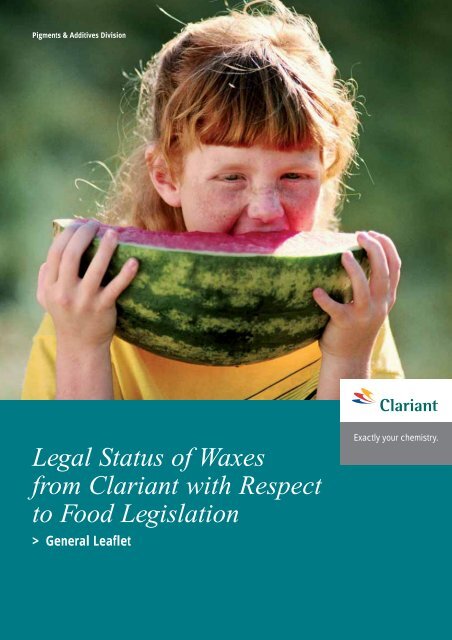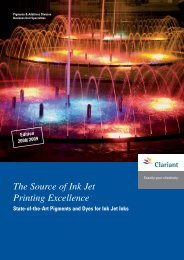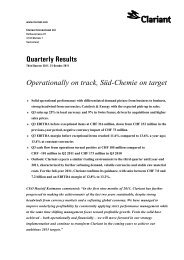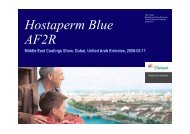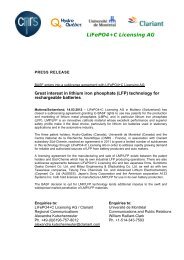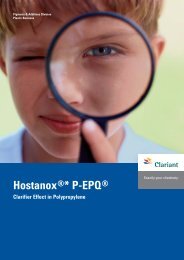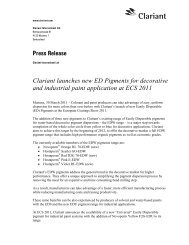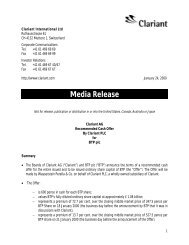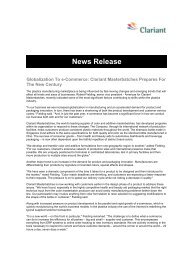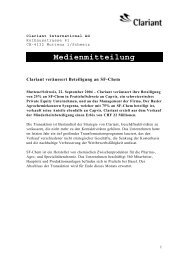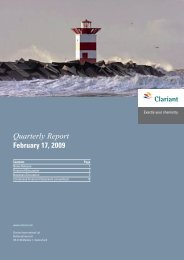Legal Status of Waxes from Clariant with Respect to Food Legislation
Legal Status of Waxes from Clariant with Respect to Food Legislation
Legal Status of Waxes from Clariant with Respect to Food Legislation
Create successful ePaper yourself
Turn your PDF publications into a flip-book with our unique Google optimized e-Paper software.
Pigments & Additives Division<br />
<strong>Legal</strong> <strong>Status</strong> <strong>of</strong> <strong>Waxes</strong><br />
<strong>from</strong> <strong>Clariant</strong> <strong>with</strong> <strong>Respect</strong><br />
<strong>to</strong> <strong>Food</strong> <strong>Legislation</strong><br />
> General Leaflet<br />
Exactly your chemistry.
<strong>Legal</strong> status <strong>of</strong> waxes <strong>from</strong> <strong>Clariant</strong><br />
<strong>with</strong> respect <strong>to</strong> food legislation<br />
According <strong>to</strong> the German Lebensmittelund<br />
Bedarfsgegenständegesetz (LMBG)<br />
(German <strong>Food</strong> and Utensils Law) only<br />
substances which are expressly permitted<br />
may be used in food (Article 11).<br />
Substances are permitted which for<br />
example prevent the spoilage <strong>of</strong> foods,<br />
preserve their natural appearance and<br />
taste (preservatives, colouring agents)<br />
or in certain cases even enabling them<br />
<strong>to</strong> be manufactured. Additives permitted<br />
for these purposes are stipulated by<br />
name – <strong>of</strong>ten <strong>with</strong> their chemical designation<br />
– in the appropriate regulations.<br />
This group includes many waxes manufactured<br />
by chemically refining natural<br />
2<br />
> General Leaflet<br />
montan wax acids, and also several<br />
waxes on the basis <strong>of</strong> low-molecular<br />
polyolefins. They are permitted as<br />
food additives in accordance <strong>with</strong> the<br />
appropriate legislation on the admissibility<br />
and marketing <strong>of</strong> food additives.<br />
The rapid development <strong>of</strong> plastics,<br />
and in particular their favourable properties<br />
for many uses, has led <strong>to</strong> an<br />
ever-increasing degree <strong>of</strong> acceptance<br />
<strong>of</strong> their use in the food industry, e.g.<br />
as eating, drinking and cooking utensils,<br />
as containers and surface protection<br />
agents and above all as packaging<br />
material.<br />
The Lebensmittel- und Bedarfsgegenständegesetz<br />
(German <strong>Food</strong> and<br />
Utensils Law) also contains regulations<br />
on utensils and packaging for food.<br />
Utensils must be so constituted that<br />
they cannot cause damage <strong>to</strong> health<br />
when used for their designated and<br />
foreseeable purpose (LMBG Articles<br />
30, 31). In addition, it is forbidden <strong>to</strong><br />
use, or <strong>to</strong> introduce on<strong>to</strong> the market<br />
for such purposes, utensils <strong>from</strong> which<br />
substances are transferred <strong>to</strong> food or<br />
its surface, except for technically unavoidable<br />
residues which are safe <strong>to</strong><br />
health and have a neutral odour and<br />
taste (Article 31, Paragraph 1).<br />
As the manufacture, processing and<br />
application <strong>of</strong> most plastics is only<br />
possible <strong>with</strong> additives, such as catalysts,<br />
stabilizers, lubricants, plasticizers<br />
etc., the appropriate regulations naturally<br />
also apply <strong>to</strong> them. The assessment<br />
<strong>of</strong> plastics intended <strong>to</strong> come in<strong>to</strong> contact<br />
<strong>with</strong> food is carried out in conjunction<br />
<strong>with</strong> the Kunstst<strong>of</strong>f-Kommission (Plastics<br />
Commission) in the Bundesinstitut für<br />
Risikobewertung (German Federal<br />
Institute for Risk Assessment) (BfR),<br />
formerly the Bundesinstitut für gesundheitlichen<br />
Verbraucherschutz<br />
und Veterinärmedizin (German Federal<br />
Institute for Consumer Health Protection<br />
and Veterinary Medicine) (BgVV).<br />
The recommendations <strong>of</strong> the BfR are<br />
published as reports in the Bundesgesundheitsblatt<br />
(German Federal Health<br />
Bulletin).
These reports do not mention any brand<br />
names, but use the chemical composition<br />
<strong>to</strong> characterize the substances<br />
which are recommended subject <strong>to</strong><br />
quantity limitations. In addition, purity<br />
requirements and further limiting properties<br />
<strong>of</strong> the substances are frequently<br />
specified.<br />
The recommendations <strong>of</strong> the BfR are<br />
not legally binding. However, manufacturers<br />
and users <strong>of</strong> utensils bear<br />
full responsibility in the case <strong>of</strong> any<br />
complaints based on the food laws.<br />
In view <strong>of</strong> the progressive integration<br />
<strong>of</strong> the single market in the EU it became<br />
necessary <strong>to</strong> specify uniform assessment<br />
criteria for plastics which come<br />
in<strong>to</strong> contact <strong>with</strong> food.<br />
EU directives were drawn up for this<br />
purpose and these were incorporated<br />
in<strong>to</strong> German law by the Bedarfsgegenständeverordnung<br />
(Regulations on<br />
Utensils) dated April 10, 1992 and subsequent<br />
guidelines. These regulations<br />
encompass substances admissible for<br />
the manufacture <strong>of</strong> cellophane and<br />
includes a list <strong>of</strong> monomers and other<br />
starting materials permitted for the<br />
manufacture <strong>of</strong> plastic utensils used<br />
in connection <strong>with</strong> food.<br />
The European <strong>Food</strong> Safety Agency<br />
(EFSA) <strong>of</strong> the EU Commission has<br />
already assessed an incomplete list <strong>of</strong><br />
additives <strong>with</strong> regard <strong>to</strong> their impact<br />
on health. This assessment is published<br />
in a Synoptic Document and its<br />
Annexes. The Synoptic Document<br />
contains a “List <strong>of</strong> Additives for Plastics<br />
and Coatings”.<br />
A legal binding directive comprising<br />
monomers and additives for plastics<br />
on an european level is EU directive<br />
2002/72/EC and amendments.<br />
The German Ministry <strong>of</strong> Health has<br />
recommended that the assessment <strong>of</strong><br />
the EFSA in the Synoptic Document –<br />
in addition <strong>to</strong> the recommendations <strong>of</strong><br />
the BfR – be taken in<strong>to</strong> consideration<br />
when evaluating additives and processing<br />
aids in plastic utensils used<br />
in connection <strong>with</strong> food.<br />
Some <strong>of</strong> the additives listed in the<br />
Synoptic Document are already included<br />
in EU Commission Directive<br />
2002/72/EC and amendments.<br />
Montan wax esters and oxidized polyethylene<br />
waxes are also permitted as<br />
coatings for citrus fruits in EU Directive<br />
No. 95/2/EC dated January 20, 1995<br />
concerning food additives other than<br />
colouring agents and sweeteners.<br />
<strong>Waxes</strong> <strong>from</strong> <strong>Clariant</strong> are used on a<br />
large scale for the manufacture and<br />
processing <strong>of</strong> numerous plastics.<br />
Their main use is in the processing <strong>of</strong><br />
PVC, in which they are highly estimated<br />
as very effective lubricants. In addition,<br />
waxes <strong>from</strong> <strong>Clariant</strong> are used e.g. in<br />
the manufacture <strong>of</strong> pigment concentrates,<br />
release agents, impregnating<br />
agents, coatings (lacquers) and contact<br />
adhesives.<br />
The application <strong>of</strong> waxes for direct<br />
and indirect food contact in the USA<br />
is regulated by <strong>Food</strong> and Drugs<br />
Administration (FDA) and is codified<br />
in Title 21 <strong>of</strong> the Code <strong>of</strong> Federal<br />
Regulations (<strong>Food</strong> and Drugs, 21 CFR).<br />
After regula<strong>to</strong>ry compliance <strong>of</strong> an<br />
additive is determined the FDA specifies<br />
detailed criteria for the use <strong>of</strong> the<br />
additive in question according <strong>to</strong> the<br />
area <strong>of</strong> application.<br />
In Japan, the Ministry <strong>of</strong> International<br />
Trade and Industry (MITI) and the<br />
Ministry <strong>of</strong> Health and Welfare (MHW)<br />
regulate questions <strong>of</strong> industrial safety<br />
and health. This includes problems relating<br />
<strong>to</strong> regula<strong>to</strong>ry approval and registration<br />
<strong>of</strong> industrial products and their<br />
bearing on food hygiene. Applications<br />
<strong>of</strong> waxes in fields relevant <strong>to</strong> food legislation<br />
are included in the positive lists<br />
<strong>of</strong> the Japan Hygienic PVC Association<br />
and the Japan Hygienic Olefin and<br />
Styrene Plastics Association.<br />
This leaflet summarizes the status <strong>of</strong><br />
waxes <strong>with</strong> regard <strong>to</strong> food legislation<br />
according <strong>to</strong> the recommendations <strong>of</strong><br />
the BfR and the regulations which<br />
apply in the EU and other countries.<br />
<strong>Status</strong>: date <strong>of</strong> printing<br />
3
The status <strong>of</strong> <strong>Clariant</strong> waxes <strong>with</strong> regard <strong>to</strong> food legislation<br />
in the Federal Republic <strong>of</strong> Germany<br />
Product Characterisation Application<br />
4<br />
Licowax ® E Ester <strong>of</strong> montan wax acids Lubricant for polymers containing plasticizers, in<br />
Licowax OP <strong>with</strong> ethandiol and/or accordance <strong>with</strong> recommendation II<br />
Licowax KPS 1,3-butandiol and/or glycerine<br />
Licowax KSL and mixtures <strong>of</strong> these esters Additive <strong>to</strong> plasticized PVC shrink foil <strong>with</strong> a high<br />
Licolub ® WE 4 <strong>with</strong> non-esterified montan wax<br />
acids and their calcium salts<br />
permeability <strong>to</strong> oxygen<br />
Lubricant for plasticizer-free PVC<br />
Lubricant for plastic piping used in equipment<br />
for draught beverages, e.g. in accordance <strong>with</strong><br />
recommendations II and XI<br />
Additive <strong>to</strong> plastic coating <strong>of</strong> cellophane and <strong>to</strong><br />
lacquers in conjunction <strong>with</strong> other recommendations<br />
Additive <strong>to</strong> polyterephthalic acid diol ester<br />
Lubricants for conveyor belts on the basis <strong>of</strong> plasticizer<br />
containing PVC, in accordance <strong>with</strong> recommendation II<br />
Lubricant for piping in the beverage industry<br />
Additive for fillers for plastic utensils<br />
Licowax E Esters <strong>of</strong> montan wax acids Lubricant or release agent for polyamide<br />
Licowax OP <strong>with</strong> ethanediol and/or<br />
Licowax KPS 1,3-butanediol and mixtures Lubricant for polycarbonate<br />
Licowax KSL <strong>of</strong> these esters <strong>with</strong> nonesterified<br />
montan wax acids<br />
and their calcium salts<br />
Release agent for unsaturated polyester resins<br />
Lubricant for plasticizer-free plastic dispersions<br />
Processing aid in hard paraffin and wax dispersions silicon<br />
resin for coating paper, in accordance <strong>with</strong> recommendation XXV
Content limited <strong>to</strong> 1) published in the Bundesgesundheitsblatt 2) BfR 3) recommendation<br />
4 % 1981, p. 238, 149 th report I<br />
– 1981, p. 295, 151 st report I<br />
4 % 1981, p. 238, 149 th report II<br />
– 1960, p. 235, 3 rd report VIII<br />
– 1970, p. 182, 59 th report<br />
0.5 % 1987, p. 112, 173 rd report XVII<br />
– 1964, p. 362, 19 th report XXVII<br />
3 % 1981, p. 295, 151 st report XXIX<br />
2 % 1984, p. 289,167 th report LII<br />
2 % 1971, p. 265, 68 th report X<br />
0.1 % 1965, p. 110, 23 rd report XI<br />
– 1964, p. 380, 20 th report XII<br />
2.5 % 1977, p. 28, 123 rd report XIV<br />
10 % 1968, p. 54, 46 th report XV<br />
1) = The reference figure must be taken <strong>from</strong> the relevant recommendations, e.g. <strong>with</strong> respect <strong>to</strong> the final product, the plastic content, solids etc.; if necessary,<br />
as the sum <strong>of</strong> various additives<br />
2) = Bundesgesundheitsblatt (German Federal Health Bulletin), Carl Heymanns Verlag KG<br />
3) = Bundesinstitut für Risikobewertung (German Federal Institute for Risk Assessment) Berlin;<br />
the latest complete version <strong>of</strong> the recommendations is published in “Kunstst<strong>of</strong>fe im Lebensmittelverkehr” (Plastics Used in the <strong>Food</strong> Industry) by Pr<strong>of</strong>. Dr. R. Frank and<br />
Dr. Helmut Wieczorek, Carl Heymanns Verlag KG<br />
5
Product Characterisation Application<br />
Licowax E Esters <strong>of</strong> montan wax acids Lubricant for melamine resin bonded boards<br />
Licowax OP <strong>with</strong> ethanediol and/or<br />
Licowax KPS 1,3-butanediol and mixtures Additive <strong>to</strong> utensils on the basis <strong>of</strong> natural and synthetic<br />
Licowax KSL these esters <strong>with</strong> nonesterified<br />
montan wax acids<br />
synthetic in accordance <strong>with</strong> recommendation XXV<br />
and their calcium salts Additive <strong>to</strong> paraffin and microwax for impregnation,<br />
coatings, contact adhesives<br />
1) = The reference figure must be taken <strong>from</strong> the relevant recommendations, e.g. <strong>with</strong> respect <strong>to</strong> the final product, the plastic content, solids etc.; if necessary,<br />
as the sum <strong>of</strong> various additives<br />
2) = Bundesgesundheitsblatt (German Federal Health Bulletin), Carl Heymanns Verlag KG<br />
6<br />
Lubricant for elas<strong>to</strong>mers made <strong>of</strong> natural and synthetic<br />
latex and for dispersions <strong>of</strong> solid rubber, in accordance<br />
<strong>with</strong> recommendation XIV<br />
Lubricant for acetal resin<br />
Additive <strong>to</strong> extender for mixed polymers made <strong>of</strong> ethylene,<br />
propylene, butylene, vinyl ester and unsaturated aliphatic<br />
acids etc., in accordance <strong>with</strong> recommendations XXV, II, III<br />
Manufacturing aid for paper, car<strong>to</strong>n and cardboard in<br />
food packaging, in accordance <strong>with</strong> recommendation<br />
XXV, and as a component <strong>of</strong> plastic dispersions in<br />
accordance <strong>with</strong> recommendation XIV<br />
Lubricant for plastic tubes used in milk processing machines<br />
Additive <strong>to</strong> utensils on the basis <strong>of</strong> polyurethane<br />
Release agent for linear polyurethane<br />
Lubricant for chlorinated PVC, plasticizer-free<br />
Surface treatment (in a mixture <strong>with</strong> paraffin microwax)<br />
for synthetic sausage skins made <strong>of</strong> cellophane,<br />
in accordance <strong>with</strong> recommendation XXV<br />
Additive <strong>to</strong> synthetic sausage skins made <strong>of</strong> polyamide<br />
Additive <strong>to</strong> <strong>to</strong>ys made <strong>of</strong> plastic and other polymers etc.,<br />
in conjunction <strong>with</strong> various other recommendations
Content limited <strong>to</strong> 1) published in the Bundesgesundheitsblatt 2) BfR 3) recommendation<br />
1 % 1961, p. 294, 9 th report XVIII<br />
0.3 % 1968, p. 9, 42 nd report XXI<br />
10 % 1967, p. 168, 38 th report XXV<br />
2.5 % 1966, p. 288, 32 nd report XXXII<br />
0.2 % 1969, p. 313, 54 th report XXXIII<br />
– 1966, p. 209, 30 th report XXXV<br />
2 % 1967, p. 24, 34 th report XXXVI<br />
2.5 % 1977, p. 28, 123 rd report<br />
3 % 1967, p. 316, 40 th report XXXVIII<br />
1.5 % 1975, p. 105, 111th report<br />
1980, p. 100, 139<br />
XXXIX<br />
th report<br />
1.5 % 1975, p. 105, 111 th report XLI<br />
8 % 1969, p. 209, 53 rd report XLII<br />
10 % 1971, p. 245, 67 th report XLIV<br />
2 % 1971, p. 245, 67 th report XLIV<br />
– 1973, p. 170, 93 rd report XLVII<br />
3) = Bundesinstitut für Risikobewertung (German Federal Institute for Risk Assessment) Berlin;<br />
the latest complete version <strong>of</strong> the recommendations is published in “Kunstst<strong>of</strong>fe im Lebensmittelverkehr” (Plastics Used in the <strong>Food</strong> Industry) by Pr<strong>of</strong>. Dr. R. Frank and<br />
Dr. Helmut Wieczorek, Carl Heymanns Verlag KG<br />
7
Product Characterisation Application<br />
Licowax E Esters <strong>of</strong> montan wax acids Additive <strong>to</strong> outer coating <strong>of</strong> hollow glassware<br />
Licowax OP <strong>with</strong> ethanediol and/or<br />
Licowax KPS 1,3-butanediol and mixtures Lubricant in PVC and its mixed polymers for the<br />
these esters <strong>with</strong> non-esterified<br />
montan wax acids and their<br />
calcium salts<br />
drinking water sec<strong>to</strong>r<br />
Licowax KPE Esters <strong>of</strong> montan wax acids<br />
<strong>with</strong> ethanediol and/or<br />
butanediol and mixtures <strong>of</strong><br />
Lubricant for melamine resin bonded boards<br />
their esters <strong>with</strong> non-esterified Manufacturing aid for paper, car<strong>to</strong>n, cardboard coming<br />
montan wax acids and their in<strong>to</strong> contact <strong>with</strong> food (as a component <strong>of</strong> plastic<br />
calcium salts, alkyl and<br />
alkylaryl ethoxylates<br />
dispersions in accordance <strong>with</strong> recommendation XIV)<br />
Licowax S Montan wax acids Additives in lacquers for cellophane<br />
Licowax E purified and/or their esters<br />
Licowax OP <strong>with</strong> ethanediol and/or<br />
Licowax KPS 1,3-butanediol and/or its<br />
Licowax KSL calcium salts<br />
Licowax OP Esters <strong>of</strong> montan wax acids Coating on citrus fruits<br />
Licowax KPS <strong>with</strong> ethanediol and/or 1,3-<br />
Licowax KSL butanediol and mixtures <strong>with</strong><br />
calcium salts <strong>of</strong> the montan<br />
wax acids<br />
Licowax C<br />
Licolub FA 1<br />
Ethylene Bisstearamide Lubricant for polymers containing plasticizers<br />
Lubricant for plasticizer-free PVC<br />
1) = The reference figure must be taken <strong>from</strong> the relevant recommendations, e.g. <strong>with</strong> respect <strong>to</strong> the final product, the plastic content, solids etc.; if necessary,<br />
as the sum <strong>of</strong> various additives<br />
2) = Bundesgesundheitsblatt (German Federal Health Bulletin), Carl Heymanns Verlag KG<br />
8<br />
Lubricant and release agent for polyethylene<br />
Lubricant and release agent for polystryrene<br />
Lubricant for styrene mixed polymers and graft
Content limited <strong>to</strong> 1) published in the Bundesgesundheitsblatt 2) BfR 3) recommendation<br />
– 1974, p. 26. 100 th report XLVIII<br />
8 % 1977, p. 12, 1st KTW report (report on the health KTW recommendation<br />
assessment <strong>of</strong> plastics and other non-metal (recommendations for the use <strong>of</strong><br />
materials for the drinking water sec<strong>to</strong>r) plastics and other non-metal<br />
materials for the drinking water<br />
sec<strong>to</strong>r)<br />
1.3.1 Polyvinyl chloride<br />
2.5 % or 4.0 mg/dm2 1972, p. 188, 77th in dispersion film<br />
report XIV<br />
1967, p. 24, 34 th report XXXVI<br />
– Bedarfsgegenständeverordnung (Regulations on<br />
utensils) dated April 11, 1994 Bundesgesetzblatt<br />
(Federal Gazette) 1994, Part I, p. 776<br />
140 mg/kg fruit Zusatzst<strong>of</strong>f-Verkehrsverordnung (Regulations on<br />
the Marketing <strong>of</strong> Additives) and Zusatzst<strong>of</strong>f-Zulassungsverordnung<br />
(Regulations on the Approval<br />
<strong>of</strong> Additives) Bundesgesetzblatt (Federal Gazette)<br />
Part I, No. 88 dated Dec. 23, 1977, p. 2696 und p. 2720<br />
2 % 1974, p. 44, 102 nd report I<br />
2 % 1974, p. 44, 102 nd report II<br />
2 % 1975, p. 49, 110 th report III<br />
2 % 1968, p. 24, 43 rd report V<br />
3 % 1976, p. 308, 121 st report VI<br />
3) = Bundesinstitut für Risikobewertung (German Federal Institute for Risk Assessment) Berlin;<br />
the latest complete version <strong>of</strong> the recommendations is published in “Kunstst<strong>of</strong>fe im Lebensmittelverkehr” (Plastics Used in the <strong>Food</strong> Industry) by Pr<strong>of</strong>. Dr. R. Frank and<br />
Dr. Helmut Wieczorek, Carl Heymanns Verlag KG<br />
9
Product Characterisation Application<br />
Licowax C<br />
Licolub FA 1<br />
Ethylene Bisstearamide Lubricant and release agent for polypropylene<br />
Lubricant for plastic piping used in equipment for draught<br />
beverages, in conjunction <strong>with</strong> other recommendations<br />
1) = The reference figure must be taken <strong>from</strong> the relevant recommendations, e.g. <strong>with</strong> respect <strong>to</strong> the final product, the plastic content, solids etc.; if necessary,<br />
as the sum <strong>of</strong> various additives<br />
2) = Bundesgesundheitsblatt (German Federal Health Bulletin), Carl Heymanns Verlag KG<br />
10<br />
Lubricant or release agent for polyamide<br />
Surface treatment for cellophane film<br />
Additive <strong>to</strong> plastic coatings <strong>of</strong> cellophane,<br />
in conjunction <strong>with</strong> other recommendations<br />
Processing aid for polyterephthalic acid diol ester<br />
Additive <strong>to</strong> conveyer belts on the basis <strong>of</strong> PVC<br />
containing plasticizer, in accordance <strong>with</strong> recommendation II<br />
Lubricant for acetal resin<br />
Additive <strong>to</strong> mixed polymers made <strong>of</strong> ethylene, propylene,<br />
butylene, vinyl esters etc., in accordance <strong>with</strong><br />
recommendations II, III<br />
Processing aid in plastic for surface coating <strong>of</strong> paper and<br />
cardboard, in conjunction <strong>with</strong> various other recommendations<br />
Additive <strong>to</strong> utensils on the basis <strong>of</strong> polyurethane<br />
Additive <strong>to</strong> plasticizer-free chlorinated PVC, its mixed<br />
polymers and polymer blends, in accordance <strong>with</strong><br />
recommendation II<br />
Additive <strong>to</strong> PVC for the surface treatment <strong>of</strong> synthetic<br />
sausage skins made <strong>of</strong> cellophane, in accordance <strong>with</strong><br />
recommendation II
Content limited <strong>to</strong> 1) published in the Bundesgesundheitsblatt 2) BfR 3) recommendation<br />
2 % 1975, p. 49, 110 th report VII<br />
– 1960, pS. 235, 3 rd report VIII<br />
2 % 1971, p. 265, 68 th report X<br />
0.5 % mg/dm 2 1979, p. 401, 136 th report XIII<br />
– 1970, p. 182, 59 th report XIII<br />
0.5 % Report <strong>of</strong> the BfR dated March 6, 1996 XVII<br />
2 % 1964, p. 362, 19 th report XXVII<br />
0.2 % 1969, p. 313, 54 th report XXXIII<br />
0.03 % 1988, p. 365, 179 th report XXXV<br />
– 1967, p. 14, 34 th report XXXVI<br />
2 % 1974, p. 43, 101st report<br />
1980, p. 100, 134<br />
XXXIX<br />
th report<br />
< 1 % 1969, p. 209, 53 rd report XLII<br />
2 % 1971, p. 245, 67 th report XLII<br />
3) = Bundesinstitut für Risikobewertung (German Federal Institute for Risk Assessment) Berlin;<br />
the latest complete version <strong>of</strong> the recommendations is published in “Kunstst<strong>of</strong>fe im Lebensmittelverkehr” (Plastics Used in the <strong>Food</strong> Industry) by Pr<strong>of</strong>. Dr. R. Frank and<br />
Dr. Helmut Wieczorek, Carl Heymanns Verlag KG<br />
11
Product Characterisation Application<br />
Licowax C Ethylene Bisstearamide Additive <strong>to</strong> polyethylene and polypropylene for synthetic<br />
Licolub FA 1 sausage skins, in accordance <strong>with</strong> recommendation III or VII<br />
12<br />
Additive <strong>to</strong> cross-linked polyethylene<br />
Additive <strong>to</strong> <strong>to</strong>ys made <strong>of</strong> plastic, in conjunction <strong>with</strong><br />
various other recommendations<br />
Additive for fillers for utensils made <strong>of</strong> plastic<br />
Lubricant in PVC and its mixed polymers for the<br />
drinking water sec<strong>to</strong>r<br />
Lubricant in polyethylene for the drinking water<br />
Licomont ®CaV 102 Montan acids calcium salt Stabilizer for polyethylene<br />
Licomont NaV 101 Montan acids sodium salt Nucleating agent for PET<br />
Licowax PE 130 Low-molecular polyolefins Lubricant for polymers containing plasticizers,<br />
Licowax PE 190<br />
Licowax PE 520 Lubricant for plasticizer-free PVC<br />
Licowax PP 230<br />
Additive <strong>to</strong> plastic piping used in equipment for draught<br />
beverages, in accordance <strong>with</strong> recommendation II<br />
Processing aid for colorants <strong>to</strong> colour plastics<br />
Surface treatment for cellophane film, in accordance<br />
<strong>with</strong> recommendations II and XXV<br />
1) = The reference figure must be taken <strong>from</strong> the relevant recommendations, e.g. <strong>with</strong> respect <strong>to</strong> the final product, the plastic content, solids etc.; if necessary,<br />
as the sum <strong>of</strong> various additives<br />
2) = Bundesgesundheitsblatt (German Federal Health Bulletin), Carl Heymanns Verlag KG
Content limited <strong>to</strong> 1) published in the Bundesgesundheitsblatt 2) BfR 3) recommendation<br />
2 % 1971, p. 245, 67 th report XLIV<br />
2 % 1972, p. 205, 79 th report XLVI<br />
– 1973, p. 170, 93 rd report XLVII<br />
– 1984, p. 289, 167 th report LII<br />
2 % 1977, p. 12, 1st KTW report (report on the health KTW recommendation<br />
assessment <strong>of</strong> plastics and other non-metal (recommendations for the use <strong>of</strong><br />
materials for the drinking water sec<strong>to</strong>r) plastics and other non-metal materials<br />
for the drinking water sec<strong>to</strong>r)<br />
1.3.1. Polyvinylchlorid<br />
2 % 1977, p. 58, 1st KTW report (report on the health KTW recommendation<br />
assessment <strong>of</strong> plastics and other non-metal (recommendations for the use <strong>of</strong><br />
materials for the drinking water sec<strong>to</strong>r) plastics and other non-metal materials<br />
for the drinking water sec<strong>to</strong>r)<br />
1.3.2. Polyethylen<br />
0.3 % 1993, p. 114, 189 th report III<br />
0.4 % 1972, p. 31, 73 rd report XVII<br />
8 % 1964, p. 407, 21 st report I<br />
8 % 1968, p. 272, 48 th report II<br />
– 1960, p. 235, 3 rd report VII<br />
– 1971, p. 278, 69 th report IX<br />
– 1970, p. 182, 59 th report XIII<br />
3) = Bundesinstitut für Risikobewertung (German Federal Institute for Risk Assessment) Berlin;<br />
the latest complete version <strong>of</strong> the recommendations is published in “Kunstst<strong>of</strong>fe im Lebensmittelverkehr” (Plastics Used in the <strong>Food</strong> Industry) by Pr<strong>of</strong>. Dr. R. Frank and<br />
Dr. Helmut Wieczorek, Carl Heymanns Verlag KG<br />
13
Product Characterisation Application<br />
Licowax PE 130 Low-molecular polyolefins Additive <strong>to</strong> coatings <strong>of</strong> cellophane, in conjunction <strong>with</strong><br />
Licowax PE 190 other recommendations<br />
Licowax PE 520<br />
Licowax PP 230 Additive <strong>to</strong> hard paraffin and wax dispersions for silicon resin<br />
for coating paper, in accordance <strong>with</strong> recommendation XXV<br />
14<br />
Additive <strong>to</strong> polyterephthalic acid diol ester<br />
Additive <strong>to</strong> utensils on the basis <strong>of</strong> natural and synthetic<br />
rubber, in accordance <strong>with</strong> recommendation XXV<br />
Additive <strong>to</strong> impregnations, coatings, contact adhesives<br />
Additive <strong>to</strong> conveyer belts on the basis <strong>of</strong> PVC containing<br />
plasticizer, in accordance <strong>with</strong> recommendation II<br />
Additive <strong>to</strong> latex and dispersions <strong>of</strong> natural and synthetic<br />
rubber, in accordance <strong>with</strong> recommendation XXI Licowax PP 230<br />
Additive <strong>to</strong> mixed polymers made <strong>of</strong> ethylene, propylene,<br />
butylene etc., in accordance <strong>with</strong> recommendation II<br />
Additive <strong>to</strong> surface treatments and coatings on paper, car<strong>to</strong>n<br />
and cardboard, in accordance <strong>with</strong> recommendation XXV<br />
Additive <strong>to</strong> plasticizer-free PVC, its mixed polymers and<br />
polymer blends, in accordance <strong>with</strong> recommendation II<br />
In mixtures <strong>with</strong> paraffin for the surface treatment <strong>of</strong><br />
synthetic sausage skins made <strong>of</strong> cellophane in accordance<br />
<strong>with</strong> recommendation XXV<br />
Additive <strong>to</strong> <strong>to</strong>ys made <strong>of</strong> plastic, in accordance <strong>with</strong><br />
various recommendations<br />
Additive <strong>to</strong> outer coating <strong>of</strong> hollow glassware<br />
Additive for fillers for utensils made <strong>of</strong> plastic<br />
1) = The reference figure must be taken <strong>from</strong> the relevant recommendations, e.g. <strong>with</strong> respect <strong>to</strong> the final product, the plastic content, solids etc.; if necessary,<br />
as the sum <strong>of</strong> various additives<br />
2) = Bundesgesundheitsblatt (German Federal Health Bulletin), Carl Heymanns Verlag KG
Content limited <strong>to</strong> 1) published in the Bundesgesundheitsblatt 2) BfR 3) recommendation<br />
– 1970, p. 182, 59 th report XIII<br />
< 50 % 1968, p. 54, 46 th report XV<br />
0.5 % 1975, p. 328, 116 th report XVII<br />
< 1.5 % 1968, p. 9, 42 nd report XXI<br />
< 50 % 1967, p. 168, 38th report<br />
1984, p. 27, 162<br />
XXV<br />
nd report<br />
8 % 1964, p. 362, 19 th report XXVII<br />
< 1.5 % 1966, p. 288, 32 nd report XXXII<br />
< 4 % 1966, p. 209, 30 th report XXXV<br />
– 1967, p. 24, 34 th report XXXVI<br />
< 4 % 1969, p. 209, 53 rd report XLII<br />
– 1971, p. 245, 67 th report XLIV<br />
– 1973, p. 170, 93 rd report XLVII<br />
– 1974, p. 26, 100 th report XLVIII<br />
12 % 1984, p. 289, 167 th report LII<br />
3) = Bundesinstitut für Risikobewertung (German Federal Institute for Risk Assessment) Berlin;<br />
the latest complete version <strong>of</strong> the recommendations is published in “Kunstst<strong>of</strong>fe im Lebensmittelverkehr” (Plastics Used in the <strong>Food</strong> Industry) by Pr<strong>of</strong>. Dr. R. Frank and<br />
Dr. Helmut Wieczorek, Carl Heymanns Verlag KG<br />
15
Product Characterisation Application<br />
Licowax PE 130 Low-molecular polyolefins Lubricant in PVC and its mixed polymers for the<br />
Licowax PE 190 drinking water sec<strong>to</strong>r<br />
Licowax PE 520<br />
Licowax PP 230<br />
16<br />
Additive <strong>to</strong> chewing gum<br />
(only Licowax PE 130, PE 190, PE 520)<br />
Coating on cheese<br />
Licowax PED 121 Oxidized polyethylene wax Lubricant for polymers containing plasticizers,<br />
Licowax PED 136 in accordance <strong>with</strong> recommendation II<br />
Licowax PED 153<br />
Licowax PED 191 Lubricant for plasticizer-free PVC<br />
Licowax PED 521<br />
Licowax PED 522 Lubricant and release agent for polystryrene<br />
Licolub H 12<br />
Licolub H 22<br />
Licowax PED 121 Oxidized polyethylene wax Lubricant and release agent for stryrene mixed and<br />
Licowax PED 1101<br />
Licowax PED 136<br />
graft polymers<br />
Licowax PED 153<br />
Licowax PED 191<br />
Lubricant for PVDC polymer<br />
Licowax PED 192<br />
Licowax PED 521<br />
Licowax PED 522<br />
Licolub H 12<br />
Licolub H 22<br />
Coating on citrus fruits
Content limited <strong>to</strong> 1) published in the Bundesgesundheitsblatt 2) BfR 3) recommendation<br />
8 % 1977, p. 12, 1st KTW report (report on the KTW recommendation<br />
health assessment <strong>of</strong> plastics and other (recommendations for the use <strong>of</strong><br />
non-metal materials for the drinking water plastics and other non-metal materials<br />
for the drinking water sec<strong>to</strong>r)<br />
1.3.1 Polyvinylchloride<br />
– Zusatzst<strong>of</strong>f-Verkehrsverordnung (Regulations on<br />
the Marketing <strong>of</strong> Additives) and Zusatzst<strong>of</strong>f-<br />
Zulassungsverordnung (Regulations on the<br />
Approval <strong>of</strong> Addites) 1990<br />
10 % Käse-Verordnung (Regulations on Cheese)<br />
Bundesgesetzblatt (Federal Gazette) Part I, No. 88<br />
dated Dec. 23, 1977, p. 2738<br />
3 % 1992, p. 362, 188th report<br />
1996, p. 120, 193<br />
I<br />
rd report<br />
3% II<br />
3% V<br />
3% VI<br />
0.3 % 1993, p. 115, 189 th report XXXIV<br />
140 mg/kg fruit Zusatzst<strong>of</strong>f-Verkehrsverordnung (Regulations on the<br />
Marketing <strong>of</strong> Additives) and Zulassungsverordnung<br />
(Regulations on the Approval <strong>of</strong> Additives) Bundesgesetzblatt<br />
(Federal Gazette)<br />
Part I No. 88 dated Dez. 23, 1977, p. 2699 und p. 2720<br />
1) = The reference figure must be taken <strong>from</strong> the relevant recommendations, e.g. <strong>with</strong> respect <strong>to</strong> the final product, the plastic content, solids etc.; if necessary,<br />
as the sum <strong>of</strong> various additives<br />
2) = Bundesgesundheitsblatt (German Federal Health Bulletin), Carl Heymanns Verlag KG<br />
3) = Bundesinstitut für Risikobewertung (German Federal Institute for Risk Assessment) Berlin;<br />
the latest complete version <strong>of</strong> the recommendations is published in “Kunstst<strong>of</strong>fe im Lebensmittelverkehr” (Plastics Used in the <strong>Food</strong> Industry) by Pr<strong>of</strong>. Dr. R. Frank and<br />
Dr. Helmut Wieczorek, Carl Heymanns Verlag KG<br />
17
Admissible additives in the EU<br />
Product Characterisation Application<br />
Licowax S Montan wax acids Additives <strong>to</strong> plastics<br />
Licowax E and/or their esters <strong>with</strong> ethylene glycol<br />
Licowax OP and/or <strong>with</strong> 1,3-butanediol<br />
Licowax KPS and/or glycerine<br />
Licowax KSL PM-Ref.-Nr. 67840<br />
Licolub WE 4<br />
Licowax C<br />
Licolub FA 1<br />
Ethylene Bisstearamide Additives <strong>to</strong> plastics<br />
Licowax E Montan wax acid ester E 912 Surface treatment <strong>of</strong> citrus fruits<br />
Licowax OP<br />
Licowax KPS<br />
Licowax KSL<br />
Licolub WE 4<br />
Licowax PED 121 Oxidized polyethylene wax Surface treatment <strong>of</strong> citrus fruits<br />
Licowax PED 1101<br />
Licowax PED 136<br />
Licowax PED 153<br />
Licowax PED 191<br />
Licowax PED 192<br />
Licowax PED 521<br />
Licowax PED 522<br />
Licolub H 12<br />
Licolub H 22<br />
E 914<br />
18
Quantity Published<br />
– Directive 95/3/EC dated Feb. 14, 1995<br />
Official Journal <strong>of</strong> the European Union<br />
No. L 41/44 dated Feb. 23, 1995<br />
– Directive 95/3/EC dated Feb. 14, 1995<br />
Official Journal <strong>of</strong> the European Union<br />
No. L 41/44 dated Feb. 23, 1995<br />
– Directive 95/2/EC dated Feb. 20, 1995<br />
on other additives <strong>to</strong> food as colorants and<br />
sweeteners<br />
– Official Journal <strong>of</strong> the European Union<br />
No. L 61/1 dated March 18, 1995<br />
19
Product Characterisation Application<br />
Licowax PE 130 Polyethylene wax Additives <strong>to</strong> plastics<br />
Licowax PE 190 PM-Ref.-No. 80000<br />
Licowax PE 520<br />
Licowax PP 230 Polypropylene wax<br />
PM-Ref.-No. 81060<br />
Additives <strong>to</strong> plastics<br />
Licowax PED 121 Oxidized polyethylene wax Additives <strong>to</strong> plastics<br />
Licowax PED 1101<br />
Licowax PED 136<br />
Licowax PED 153<br />
Licowax PED 191<br />
Licowax PED 192<br />
Licowax PED 521<br />
Licowax PED 522<br />
Licolub H 12<br />
Licolub H 22<br />
PM-Ref.-No. 80077<br />
20
Quantity Published<br />
– Directive 2005/79/EC dated Nov. 18, 2005<br />
Official Journal <strong>of</strong> the European Union<br />
No. L 302/35 dated November 19, 2005<br />
– Directive 2005/79/EC<br />
– EC Additive List, Synoptic Document<br />
and amendments<br />
21
The status <strong>of</strong> <strong>Clariant</strong> waxes <strong>with</strong> regard <strong>to</strong> food legislation in other countries<br />
The legislation on food in the USA and<br />
many other countries is similar developed<br />
<strong>to</strong> that in Germany. The FDA – the<br />
<strong>Food</strong> and Drug Administration, USA –<br />
regulate the substances permitted <strong>to</strong><br />
come “in<strong>to</strong> direct or indirect contact<br />
<strong>with</strong> food” which are codified in the<br />
Title 21, Code <strong>of</strong> Federal Regulations<br />
(21 CFR).<br />
22<br />
There are also legal requirements for<br />
processing aids permitted for use in<br />
the processing <strong>of</strong> plastics in Australia,<br />
Belgium, the Czech Republic, Britain,<br />
France, the Netherlands, Italy, Japan,<br />
Austria and Spain. In many cases,<br />
countries <strong>with</strong>out their own comprehensive<br />
food legislation refer <strong>to</strong> the<br />
legal requirements valid in the Federal<br />
Republic <strong>of</strong> Germany and the USA.<br />
Country Product Characterisation<br />
United Kingdom<br />
Rec.-No. T-141 Licowax E Montan wax ester<br />
Rec.-No. T-142 Licowax OP<br />
Rec.-No. T-137 Licowax KPS<br />
Rec.-No. T-177 Licowax PE 130 Non oxidized polyethylene waxes<br />
Rec.-No. T-178 Licowax PE 190<br />
Rec.-No. T-179 Licowax PE 520<br />
Rec.-No. T-172 Licolub C Ethylene Bisstearamide<br />
The national regulations <strong>of</strong> individual<br />
countries in the European Union are<br />
increasingly becoming replaced by the<br />
EU regulations for the whole <strong>of</strong> Europe.<br />
The legal admissibility <strong>of</strong> the <strong>Clariant</strong><br />
waxes in individual countries is summarized<br />
in the following tables.<br />
Licolub WE 4 Glycerolesters <strong>of</strong> oxidatively refined montan wax acids<br />
France Licowax E Montan wax acids and esthers <strong>with</strong> ethanediol and/or<br />
Licowax OP 1,3-butanediol and mixtures these esters <strong>with</strong> non-esterified<br />
Licowax KPS<br />
Licowax KSL<br />
Licowax S<br />
montan wax acids and their calcium salts<br />
Licowax PE 130 Polyethylene wax<br />
Licowax PE 190<br />
Licowax PE 520
Application Quantity Published<br />
Lubricant for plastic 8 % BPF/BIBRA-Code <strong>of</strong> Practice 1976<br />
Additive <strong>to</strong> plastic 8 % BPF/BIBRA-Code <strong>of</strong> Practice 1991<br />
Additive <strong>to</strong> plastic 5 % BPF/BIBRA-Code <strong>of</strong> Practice 1991<br />
Lubricant for plastic – BPF/BIBRA-Code <strong>of</strong> Practice 1988<br />
Lubricant for plastic 3 % Journal <strong>of</strong>ficiel, April 16, 1959<br />
Circulaire No. 175, March 23,1959)<br />
> Lubricant for PVC, polystyrene homopolymers – Instruction dated Nov. 30, 1987<br />
and copolymers, polyolefins, polyamides and rubber<br />
> Additive <strong>to</strong> hot melt adhesives<br />
> Paper and car<strong>to</strong>n coating<br />
> Additives <strong>to</strong> lacquers and printing inks<br />
Bulletin Officiel dated Dec. 16, 1987<br />
23
Country Product Characterisation<br />
France Licowax PED 121<br />
Licowax PED 1101<br />
Licowax PED 136<br />
Licowax PED 153<br />
Licowax PED 191<br />
Licowax PED 192<br />
Licowax PED 521<br />
Licowax PED 522<br />
Licolub H 12<br />
Licolub H 22<br />
Oxidized polythylene wax<br />
24<br />
Licowax C Ethylene Bisstearamide<br />
Licolub FA 1<br />
Italy Licowax E<br />
Licowax OP<br />
Licowax KPS<br />
Licowax KSL<br />
Esters <strong>of</strong> montan wax acids <strong>with</strong> ethanediol and 1,3-butanediol<br />
Licolub WE 4 Esters <strong>of</strong> montan wax acids <strong>with</strong> glycerine<br />
Licowax C Ethylene Bisstearamide<br />
Licolub FA 1<br />
Licowax PE 130 Polyethylene<br />
Licowax PE 190<br />
Licowax PE 520<br />
Licowax PED 191 Oxidized polyethylene wax<br />
Licowax PED 192<br />
Licolub H 12<br />
Licolub H 22
Application Quantity Published<br />
> Lubricant for PVC, polystyrene homopolymers – Instruction dated Nov. 30, 1987<br />
and copolymers, polyolefins, polyamides<br />
and rubber<br />
> Additive <strong>to</strong> hot melt adhesives<br />
> Paper and car<strong>to</strong>n coating<br />
> Additives <strong>to</strong> lacquers and printing inks<br />
Bulletin Officiel dated Dec. 16, 1987<br />
Additive <strong>to</strong> plastic 2 % Journal Officiel, June 4, 1969<br />
(Circulaire dated April 2, 1969)<br />
Additive <strong>to</strong> plastic and processing aid for – Gazzetta Ufficiale No. 104,<br />
regenerated cellulose April 20, 1973<br />
Additive <strong>to</strong> plastic – Gazzetta Ufficiale Nr. 120, 23.5.85<br />
Additive <strong>to</strong> plastic and processing aid for 0.5 % in PE Gazzetta Ufficiale No. 104,<br />
regenerated cellulose and PVC<br />
in other<br />
plastics 0.2 %<br />
April 20, 1973<br />
Utensils – Gazzetta Ufficiale No. 104,<br />
April 20, 1973<br />
Unplasticized PVC – Gazzetta Ufficiale No. 198,<br />
Aug. 25, 1994<br />
25
Country Product Characterisation<br />
Spain<br />
26<br />
Licowax E Esters <strong>of</strong> the montan wax acids <strong>with</strong> ethanediol<br />
Licowax OP and/or 1,3-butanediol or glycerine and/or<br />
Licowax KPS calcium and sodium salts<br />
Licowax KSL<br />
Licolub WE 4<br />
Licowax S Purified montan wax acids<br />
Licowax C Ethylene Bisstearamide<br />
Licolub FA 1<br />
Licowax PE 130 Polyethylene waxes, polyolefins <strong>of</strong> a low<br />
Licowax PE 520<br />
Licowax PE 190<br />
degree <strong>of</strong> polymerisation<br />
Licowax PP 230 Polypropylene wax<br />
Licowax PED 121 Oxidized polyethylene waxes<br />
Licowax PED 1101<br />
Licowax PED 136<br />
Licowax PED 153<br />
Licowax PED 521<br />
Licowax PED 522<br />
Licolub H 12<br />
Licolub H 22<br />
Licowax PED 191 Oxidized polyethylene wax<br />
Licowax PED 192<br />
Switzerland To some extent these countries follow the regulations <strong>of</strong> the EU,<br />
Denmark the Federal Republic <strong>of</strong> Germany and the USA<br />
Sweden<br />
Norway
Application Quantity Published<br />
Additive <strong>to</strong> plastic for food packaging –<br />
Positive list, Ministerio de Sanidad 1982<br />
and/or registration number,<br />
Registro Sanitario Espaniol<br />
39.16/B-109<br />
39.16/B-110<br />
39.16/B-154<br />
39.16/B-132<br />
39.16/B-396<br />
Additive <strong>to</strong> plastic for food packaging – 39.16/B-130<br />
Additive <strong>to</strong> plastic for food packaging – 39.16/B-155<br />
Additive <strong>to</strong> plastic for food packaging – 39.16/B-83<br />
39.16/B-85<br />
39.16/B-84<br />
Additive <strong>to</strong> plastic for food packaging – –<br />
Coating <strong>of</strong> citrus fruits and additive <strong>to</strong> plastic and – 39.16/B-458<br />
for food packaging 39.16/B-367<br />
39.16/B-368<br />
39.16/B-152<br />
39.16/B-1<br />
Additive <strong>to</strong> plastic for food packaging – –<br />
– – –<br />
27
Country Product Characterisation<br />
The Netherlands Licowax S Montan wax acids, esters <strong>of</strong> the montan wax acids<br />
Licowax E <strong>with</strong> ethanediol and/or 1,3-butanediol and/or<br />
Licowax OP<br />
Licowax KPS<br />
Licowax KSL<br />
Licolub WE 4<br />
glycerine, calcium salts <strong>of</strong> the montan wax acids<br />
28<br />
Licowax S Montan wax acids, esters <strong>of</strong> the montan wax acids<br />
Licowax E <strong>with</strong> ethanediol and/or 1,3-butanediol and/or calcium<br />
Licowax OP salts <strong>of</strong> the montan wax acids<br />
Licowax KPS<br />
Licowax KSL<br />
Licowax C Ethylene Bisstearamide<br />
Licolub FA 1<br />
Licowax PE 130 Polyethylene, molecular weight > 200<br />
Licowax PE 190<br />
Licowax PE 520<br />
Licowax PP 230 Polypropylene, molecular weight > 400
Application Quantity Published<br />
Additives <strong>to</strong> plastics – Verpakkingen en Gebruiksartikelen<br />
Besluit (Warenwet) 1980,<br />
7th Supplement April 1994<br />
Additive for paper and car<strong>to</strong>ns, rubber products – Verpakkingen en Gebruiksartikelen<br />
(Category II + III), metals, Besluit (Warenwet) 1980,<br />
film made <strong>from</strong> regenerated cellulose, coatings 6th Supplement June 1993<br />
Additives <strong>to</strong> plastics, metals, film made <strong>from</strong> – Verpakkingen en Gebruiksartikelen<br />
regenerated cellulose Besluit (Warenwet )1980,<br />
7th Supplement April 1994<br />
Additives <strong>to</strong> plastics, metals, paper and car<strong>to</strong>n, – Verpakkingen en Gebruiksartikelen<br />
coatings Besluit (Warenwet) 1980,<br />
7th Supplement April 1994<br />
Coatings – Warenwet 1980,<br />
5th Supplement January 1992<br />
29
Country Product Characterisation<br />
Belgium Licowax S Purified montan wax acids, esters <strong>of</strong> the montan wax<br />
Licowax E acids <strong>with</strong> ethanediol and/or 1,3-butanediol and/or<br />
Licowax OP<br />
Licowax KPS<br />
Licowax KSL<br />
Licolub WE 4<br />
glycerine<br />
30<br />
Licowax C Ethylene Bisstearamide<br />
Licolub FA 1<br />
Licowax PE 130 Polyolefins <strong>of</strong> a low degree <strong>of</strong> polymerisation<br />
Licowax PE 190<br />
Licowax PE 520<br />
Licowax PP 230<br />
Licowax PED 121 Oxidized polyethylene<br />
Licowax PED 1101<br />
Licowax PED 136<br />
Licowax PED 153<br />
Licowax PED 191<br />
Licowax PED 192<br />
Licowax PED 521<br />
Licowax PED 522<br />
Licolub H 12<br />
Licolub H 22
Application Quantity Published<br />
Additive <strong>to</strong> plastic for food packaging – Official Belgian Journal<br />
dated July 24, 1992,<br />
Royal decree dated May 11, 1992<br />
Additive <strong>to</strong> plastic for food packaging – Official Belgian Journal dated July 24,<br />
1992, Royal decree dated May 11, 1992<br />
Additive <strong>to</strong> plastic for food packaging – Official Belgian Journal<br />
dated July 24, 1992,<br />
Royal decree dated May 11, 1992<br />
Additive <strong>to</strong> plastics – Official Belgian Journal<br />
dated July 24, 1992,<br />
Royal decree dated May 11, 1992<br />
31
Country Product Characterisation<br />
Austria Licowax E Montan wax acids:<br />
Licowax OP esters <strong>of</strong> the montan wax acids <strong>with</strong> ethanediol<br />
Licowax KPS<br />
Licowax KSL<br />
and/or 1,3-butanediol<br />
32<br />
Licolub WE 4 Esters <strong>of</strong> the montan wax acids <strong>with</strong> glycerine<br />
Licowax KPE Esters <strong>of</strong> the montan wax acids <strong>with</strong> ethanediol<br />
and/or 1,3-butanediol and alkylaryl and aryl ethoxylates<br />
Licowax C Ethylene Bisstearamide<br />
Licolub FA 1<br />
Licowax PE 130 Low-molecular polyolefins<br />
Licowax PE 190<br />
Licowax PE 520<br />
Licowax PP 230<br />
Licowax PED 121 Oxidized polyethylene waxes<br />
Licowax PED 1101<br />
Licowax PED 136<br />
Licowax PED 153<br />
Licowax PED 191<br />
Licowax PED 192<br />
Licowax PED 521<br />
Licowax PED 522<br />
Licolub H 12<br />
Licolub H 22
Application Quantity Published<br />
Lubricant for plastic 2 % Austrian Health Authority Bulletin,<br />
77th year, dated March 15,1976, p. 73<br />
Lubricant for PVC max. 2 % Plastic Additive List September 1995,<br />
Austrian Chamber <strong>of</strong> Commerce<br />
Additive <strong>to</strong> plastic for food packaging 2 % Austrian Health Authority Bulletin,<br />
77th year, dated March 15, 1976, p. 73<br />
Lubricant for plastic 2 % Austrian Health Authority Bulletin,<br />
77th year, dated March 15, 1976, p. 73<br />
Additive <strong>to</strong> hard paraffin and microwax, resin – Austrian Health Authority Bulletin,<br />
and plastic for impregnated coatings and contact 77th adhesives<br />
year, dated March 15, 1976, p. 73<br />
Lubricant for PVC, polystyrene homopolymers max. 3 % Plastic Additive List September 1995,<br />
and mixed polymers Austrian Chamber <strong>of</strong> Commerce<br />
33
Country Product Characterisation<br />
Czech Republic Licowax E Vosk E<br />
Licowax OP Vosk OP<br />
Australia<br />
4) = In positive lists which use the trade name <strong>of</strong> the permitted products the old designation for polyethylene wax is still partly used, e. g. Hoechst Wax PA 520.<br />
In 1977 the nomenclature was changed. Since then, PA wax has been called PE wax, e. g. PE 520.<br />
34<br />
Licowax C Vosk C,<br />
or Ethylene Bisstearamide<br />
Licowax PE 520 Vosk PA 520 4)<br />
Licowax E Montan waxes<br />
Licowax OP<br />
Licowax KPS<br />
Licowax KSL<br />
Licolub WE 4<br />
Licowax C Ethylene Bisstearamide<br />
Licolub FA 1<br />
Licowax PE 130 Polyethylene<br />
Licowax PE 190<br />
Licowax PE 520
Application Quantity Published<br />
Lubricant for polyethylene, polyamide (basis<br />
caprolactam), PVC, polystyrene, polyvinyl<br />
acetate, polypropylene, melamine formaldehyde<br />
resin, styrene copolymers<br />
– Hygienické P`´redpisy Svazek 42/1978<br />
Lubricant for: Polyethylen 0.2 % Hygienické P`´redpisy Svazek 42/1978<br />
Polystyrene 0.2 %<br />
Styrene copolymers 0.5 %<br />
Lubricant for: PVC 1.5 % Hygienické P`´redpisy Svazek 42/1978<br />
Polystyrene –<br />
Styrene copolymers 0.5 %<br />
Additive <strong>to</strong> PVC 3 %<br />
Australian Standard<br />
AS 2070.2-1992<br />
AS 2070.8-1992<br />
Additive for PE 5 % AS 2070.1-1992<br />
PVC 5 % AS 2070.2-1992<br />
Polystyrene 0.5 % AS 2070.3-1992<br />
Polyacrylnitrile 5 % AS 2070.4-1992<br />
Polypropylene 5 % AS 2070.5-1992<br />
AS 2070.8-1992<br />
Additive <strong>to</strong> polyacrylnitrile 3 % AS 2070.4-1992<br />
AS 2070.8-1992<br />
35
Country Product Characterisation<br />
USA Licowax E Polyhydric alcohol diesters <strong>of</strong> oxidatively refined<br />
Licowax OP (Gersth<strong>of</strong>en process) montan wax acids<br />
36<br />
Licowax KPS Polyhydric alcohol diesters <strong>of</strong> oxidatively refined<br />
Licowax KPE (Gersth<strong>of</strong>en process) montan wax acids<br />
Licowax E Polyhydric alcohol diesters <strong>of</strong> oxidatively refined<br />
Licowax OP (Gersth<strong>of</strong>en process) montan wax acids<br />
Licowax KPS<br />
Licowax KPE<br />
Licolub WE 4 Polyhydric alcohol diesters <strong>of</strong> oxidatively refined<br />
(Gersth<strong>of</strong>en process) montan wax acids<br />
Licowax E Polyhydric alcohol diesters <strong>of</strong> oxidatively refined<br />
Licowax KPS (Gersth<strong>of</strong>en process) montan wax acids<br />
Licowax E Conversion product <strong>of</strong> montan wax acids <strong>with</strong><br />
Licowax KSL ethylene glycol<br />
Licowax C Ethylene Bisstearamide<br />
Licolub FA 1<br />
Licowax KP 303 Montan wax
Application Quantity Published<br />
Lubricant for food-contact utensils made <strong>of</strong> PVC – Code <strong>of</strong> Federal Regulations (FDA) Title 21<br />
§ 178.3770 (a)<br />
Release agent in resin and polymer coating for 5 % in § 178.3770 (b)<br />
polyolefin film in acc. <strong>with</strong> § 175.320 conjunction<br />
<strong>with</strong> § 178.3400<br />
Additive in aqueous PVDC dispersions – § 178.3770 (c)<br />
Lubricant in PVC – § 178.3770 (d)<br />
Coating on citrus fruits – § 172.210 (b)<br />
Additive in paper and paperboard – § 176.170<br />
§ 176.180<br />
Additive <strong>to</strong> cellophane, – § 177.1200<br />
release agent § 175.300<br />
component <strong>of</strong> adhesives, § 175.105<br />
component <strong>of</strong> paper and paperboard in contact<br />
<strong>with</strong> aqueous and fatty food<br />
§ 176.170<br />
component <strong>of</strong> paper and paperboard in contact <strong>with</strong> dry food, § 176.180<br />
additive <strong>to</strong> polymers Prior Sanction<br />
Component <strong>of</strong> adhesives – § 175.105<br />
component <strong>of</strong> rubber articles § 177.2600<br />
37
Country Product Characterisation<br />
USA Licowax PE 130<br />
Licowax PE 190<br />
Licowax PE 520<br />
Polyethylene wax<br />
38<br />
Licowax PE 130 Olefin polymers<br />
Licowax PE 190<br />
Licowax PE 520<br />
Licowax PP 230 Polypropylene
Application Quantity Published<br />
Additive for<br />
> chewing gum – § 172.615<br />
> adhesives – § 175.105<br />
> contact adhesives – § 175.125<br />
> resin and polymer coatings – § 175.300<br />
> coating <strong>of</strong> polyolefin films max. 90 % § 175.320<br />
> paper and paperboard in contact <strong>with</strong><br />
aqueous and fatty food<br />
50 % § 176.170<br />
> paper and paperboard in contact <strong>with</strong> dry food – § 176.180<br />
> cellophane – § 177.1200<br />
> closure <strong>with</strong> sealing gaskets for food containers – § 177.1210<br />
> rubber articles for repeated use max. 2 % § 177.2600<br />
> textile and textile fibres max. 50 % § 177.2800<br />
> lubricants <strong>with</strong> incidental food contact – § 178.3570<br />
> reinforced wax for packaging cheese – § 178.3850<br />
Additive for articles in contact <strong>with</strong> food – § 177.1520 (c) 2.1, 2.3<br />
– § 177.1520 (c) 2.1, 2.2, 2.3<br />
max. 50 % § 177.1520 (c) 2.3<br />
Additive for articles in contact <strong>with</strong> food – § 177.1520 (c) 1.2<br />
component <strong>of</strong> adhesives – § 175.105<br />
39
Country Product Characterisation<br />
USA Licowax PED 121 Polyethylene, oxidized<br />
Licowax PED 191<br />
Licowax PED 192<br />
Licowax PED 521<br />
Licolub H 12<br />
(acid value 9-19)<br />
40
Application Quantity Published<br />
Additive for<br />
> fruit coating – § 172.260<br />
> adhesives – § 175.105<br />
> pressure sensitive adhesives – § 175.125<br />
> resin and polymer coatings – § 175.300<br />
> coating <strong>of</strong> polyolefin films – § 175.320<br />
> paper and paperboard in contact <strong>with</strong><br />
aqueous and fatty food<br />
– § 176.170<br />
> paper and paperboard in contact <strong>with</strong> dry food – § 176.180<br />
> cellophane – § 177.1200<br />
> closures <strong>with</strong> sealing gaskets – § 177.1210<br />
> articles in contact <strong>with</strong> food – § 177.1620<br />
> rubber articles for repeated use – § 177.2600<br />
> textile and textile fibres – § 177.2800<br />
> lubricants <strong>with</strong> incidental food contact § 178.3570<br />
> reinforced wax for packaging cheese – § 178.3850<br />
41
Country Product Characterisation<br />
Japan<br />
42<br />
Licowax E Montan wax acids, ester <strong>of</strong> ethanediol<br />
Licowax OP Montan wax acids, ester <strong>of</strong> 1,3-butanediol<br />
Licowax S Montan wax acids<br />
Licowax E Montan wax acids, ester <strong>of</strong> ethanediol<br />
Licowax OP Montan wax acids, ester <strong>of</strong> 1,3-butanediol<br />
Licowax E Montan wax acids, ester <strong>of</strong> ethanediol<br />
Licowax OP Montan wax acids, ester <strong>of</strong> 1,3-butanediol<br />
Licowax E Montan wax acids, ester <strong>of</strong> ethanediol<br />
Licowax OP Montan wax acids, ester <strong>of</strong> 1,3-butanediol<br />
Licowax S Montan wax acids<br />
Licolub WE 4 Montan wax acids, glycerol ester<br />
Licowax S Montan wax acids<br />
Licomont CaV 102 Montan acids calcium salt
Application Quantity Published<br />
PVC – J-0277<br />
PE – [B] NM-0644<br />
BDR –<br />
PED 3.0 %<br />
PET 3.0 % [B] NM-0644<br />
PS – [B] NL-0611<br />
PA 2.0 %<br />
PC 0.1 %<br />
POM 0.2 %<br />
PE 3.0 % [B] NL-0645<br />
PP 2.0 %<br />
ABS 3.0 %<br />
PC 0.1 %<br />
PE 3.0 % [B] NL-0762<br />
PP 2.0 %<br />
ABS 3.0 %<br />
PC 0.1 %<br />
POM 0.2 %<br />
PBT –<br />
PS – [B] NL-1200<br />
ABS –<br />
PA 2.0 %<br />
PBT –<br />
PET –<br />
PC 0.1 %<br />
POM 0.2 %<br />
Positive lists <strong>of</strong> the Japan Hygienic PVC<br />
Association (J-XXXX) and Japan Hygienic<br />
Olefin and Styrene Plastics Association<br />
([B]XX-XXXX)<br />
43
Country Product Characterisation<br />
Japan<br />
44<br />
Licomont NaV 101 Montan acids sodium salt<br />
Licowax C Ethylene Bisstearamide<br />
Licolub FA 1<br />
Licowax C Ethylene Bisstearamide<br />
Licolub FA 1<br />
Licowax PE 130 Polyethylene wax<br />
Licowax PE 190<br />
Licowax PE 520<br />
Licowax PE 130 Polyethylene wax<br />
Licowax PE 190<br />
Licowax PE 520
Application Quantity Published<br />
PE 0.4 % [B] NL-1201<br />
PP 0.4 %<br />
PS 0.4 %<br />
PA 0.4 %<br />
PET 0.4 %<br />
POM 0.4 %<br />
PPE 0.4 %<br />
PVC – J-0278<br />
PE 0.5 % [B] NL-0648<br />
PP 2.0 %<br />
PMP 0.2 %<br />
PS 0.4 %<br />
AS 2.0 %<br />
ABS 2.0 %<br />
PMMA 0.2 %<br />
PB-1 0.2 %<br />
BDR 0.2 %<br />
PA 0.2 %<br />
PET 0.2 %<br />
PC 0.2 %<br />
PVC – J-0279<br />
PE – [B] NL-0647<br />
PP –<br />
PS –<br />
AS –<br />
ABS –<br />
PET 0.5 %<br />
PC –<br />
Positive lists <strong>of</strong> the Japan Hygienic PVC<br />
Association (J-XXXX) and Japan Hygienic<br />
Olefin and Styrene Plastics Association<br />
([B]XX-XXXX)<br />
45
Country Product Characterisation<br />
Japan<br />
46<br />
Licowax PP 230 Polypropylene<br />
Licowax PED 521 Oxidized polyethylene<br />
Licowax PED 121
Application Quantity Published<br />
PE – [B] NJ-0920<br />
PP –<br />
PMP –<br />
PS –<br />
ABS –<br />
PMMA –<br />
PB-1 –<br />
BDR –<br />
PA –<br />
PET –<br />
PC –<br />
PE – [B] NJ-0649<br />
PP –<br />
PS –<br />
AS –<br />
ABS –<br />
BDR –<br />
Positive lists <strong>of</strong> the Japan Hygienic PVC<br />
Association (J-XXXX) und Japan Hygienic<br />
Olefin and Styrene Plastics Association<br />
([B]XX-XXXX)<br />
47
Please note<br />
This information is based on our present state <strong>of</strong> knowledge and is intended <strong>to</strong> provide<br />
general notes on our products and their uses. It should not therefore be construed<br />
as guaranteeing specific properties <strong>of</strong> the products described or their suitability for<br />
a particular application. Any existing industrial property rights must be observed.<br />
The quality <strong>of</strong> our products is guaranteed under our General Conditions <strong>of</strong> Sale.<br />
® = Trademark <strong>of</strong> <strong>Clariant</strong> registered in numerous countries.<br />
Edition: November 2006<br />
www.pa.clariant.com<br />
<strong>Clariant</strong> International Ltd.<br />
Pigments & Additives Division<br />
Rothausstrasse 61<br />
4132 Muttenz<br />
Switzerland<br />
Phone: +41/61/469-7921<br />
Fax: +41/61/469-7543<br />
Exactly your chemistry.<br />
DA 8250 E_11/06


